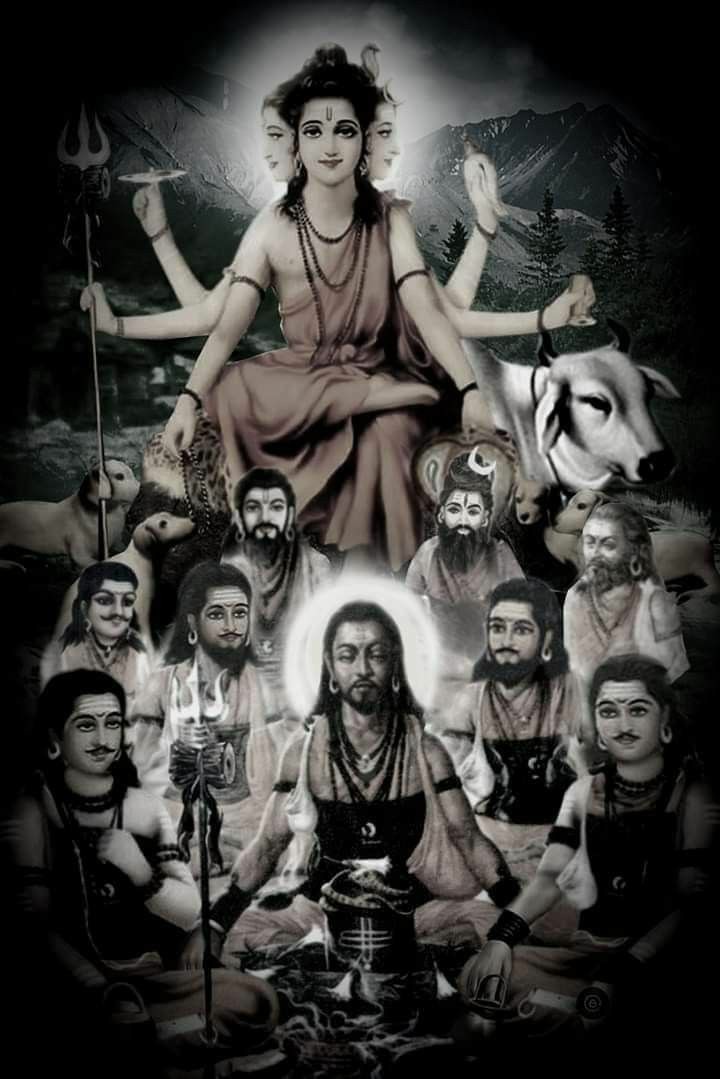
|
|
|
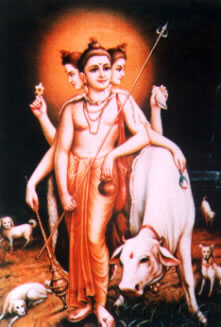
मालाकमंडलुरधः करपद्मयुग्मे, मध्यस्थ पाणियुगुले डमरूत्रिशूले
यस्यस्त उर्ध्वकरयोः शुभशंखचक्रे वंदे तमत्रिवरदं भुजषटकयुक्तम
I bow to the son of Atri, who has six hands and whose lowest two hands have Mala and kamandalu,
middle couple of hands hold Damaru and Trishool and top two hands have holy Shankh and Chakra
HISTORY
Dattatreya, a divinity that includes the Trimurti, Brahma (the Creator), Vishnu (the Preserver) and Shiva (the Destroyer), is considered the founder of this school.
It is represented as an ascetic with the three heads of Brahma, Vishnu
and Shiva together with four dogs that represent the four Veda. He has in
the hands some objects of spiritual meaning: kamandal (water's pitcher);
japa mala (rosary); damru (drum); trisul (trident);
shankar (shell); sudarshan (disk). Damru and trisul are
in association with
Shiva, while the disk and the shell with Vishnu.
Pitcher for the water and rosary are the few possessions of an ascetic.
Dattatreya's parents were a very devoted couple and practised many tapasyas (austerity) to get a very desired child. His mother wanted intensely her child to be the incarnation of the Nirguna Parabrahman (the Supreme Brahman without form).But since it was impossible that the without-form could take a form, Brahma, Vishnu and Shiva granted her that her child would have been their child embodying all three the divinities.
Dattatreya is considered the highest expression of the ascetic, of the
renouncer, since He has known how to draw from every thing the suggestion for
the deepest meditations. Also something considered by everybody meaningless or
negative, can teach us a lot. In his Avadhut Gita He said he had
24 Gurus: the earth, the
water, the fire, the wind, various animals, etc. That's how he
learned the various virtues, finding the spiritual education through these and
other natural phenomenons.
"There are no sacred writings, there are no sacrifices, Gods, religions, there
are no colors, there are no levels, there are no classes, there are no groups,
there is neither some dark path nor some bright path, last reality is only the
beauty of the spirit." (Avadhut Gita)
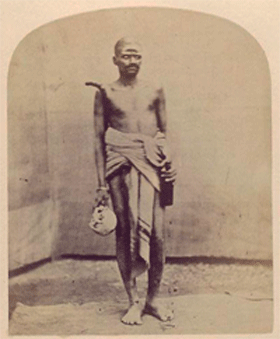
In reality is difficult to draw a historical map of the Aghori babas. There are no official figures. Few and veiled of mystery are the news on their account. The few news that we have come from Persian sources of 1500 D.C. and from English relationships of the XVIII century. Besides this philosophy of life trespasses sometimes on other mystical schools (as the Sufis for es.), taking some techniques of meditation of it and weaving them with others. Some Aghoris have also had muslim guru or of other faiths. Despite this, the Aghoris represent an ancient tradition and there have been periods in which this particular family of sadhu has been very numerous. Today the devotion to these babas is largely practiced among the Indian middle class.
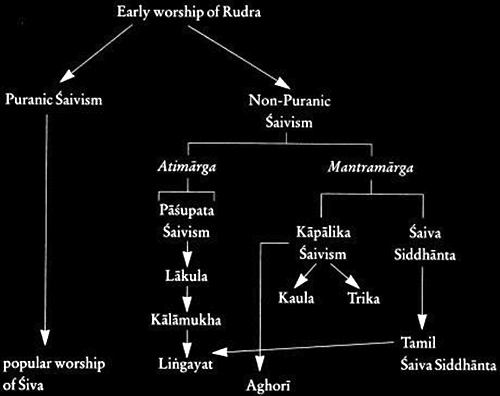
The most greater center is the Kina Ram Ashram and in the fields of
cremation in Varanasi (Benares), center of important pilgrimage for the devoted
Aghoris. Kina Ram is a sadhu lived in the '700 and considered to be an
incarnation of Shiva.
It has esteems that to the beginning of the '900 in all Varanasi there were not
more than 300 Aghoris while to our days they esteem only an about twenty, in the
whole India perhaps a hundred.
Kina Ram
Baba Kina Ram was one of the greatest saint in India. Born at Ramgarth village of Chandauli district of Uttar Pradesh in a zamindar (official employed by the Mughals to collect taxes from peasants) family of Akbar Singh and Mansa Devi. He showed sign of divinity from the very beginning. He had no interest in mundane activities of day to day life but showed inclination towards renunciation and reclusive life style that really worried his parents who married him at an early age but the newlywed bride died before second marriage (Gavama). Baba Kina Ram left his house just after this incident and got himself initiated by Baba Shiva Ram. Later on he traveled throughout India and visited all the major pilgrimages.
He practiced severe sadhana at Baluchistan in the temple of Mata Hingalaj, who directed him to Girnar mountain in Gujarat and thereafter he was told to proceed to Varanasi. At Girnar, he had darshan of Bhagwan Dattatreya and attained divine siddhi (power). Baba Kina Ram set a fire to Agneya Rudra at Krim Kund which had been burning for the last 400 years. Bija Ram and Ram Jeyawan were his famous disciples.
During Mughal rule the society was plagued with several iniquity. Baba Kina Ram opposed the tyranny of local rulers and taught people to rise above caste, creed and sectarian views. He showed miracles to prove that a true saint transcended human power and could not be cowed down by rulers or kings who led luxurious life. The stories of his miracles are very famous in North India. He was laid to rest in the lap of Mata Hingalaj at Krim Kund and thereafter the charge of ashram passed on to Bija Ram.
Clans
|
KALI KULAM
|
TARA KULAM
|
SHRI KULAM
|
TRIPURA KULAM
|
||||||
|
KALI
|
DHUMAVATI
|
TARA
|
CHINNAMASTA
|
BAGALA MUKHI
|
MATANGI
|
KAMALA
|
TRIPURA SUNDARI
|
TRI BHUVANESVARI
|
TRIPURA BHAIRAVI
|
|
AGHORA PANT
|
VAMA PANT
|
SHRI PANT (ANANDA NATH)
|
TRIPURA PANT
|
||||||
| ANANDA BHAIRAVA NATH
|
|||||||||
THE 24 NATURAL GURUS OF DATTATREYA
|
1) PRITHVI (mother earth) |
9) AJGAR (python) |
17) PINGALA (a courtesan) |
|
2) VAYU (wind) |
10) SINDU (ocean) |
18) KURARAPAKSHI (a bird of pray) |
|
3) AKASHA (space - sky) |
11) PATANGA (bugs) |
19) BALAK (children) |
|
4) JAL (water) |
12) BHRAMAR (black bee) |
20) KUMARI (virgin) |
|
5) AGNI (fire) |
13) MADHUKSHIKA (honey-gatherer) |
21) SHARAKRIT (arrow maker) |
|
6) CHANDRA (moon) |
14) GAJ (elephant) |
22) SANF (snake) |
|
7) SURYA (sun) |
15) MRIG (deer) |
23) MAKADI (spider) |
|
8) KAPOT (pigeon) |
16) MIN (fish) |
24) BHRINGI (a species of wasp) |
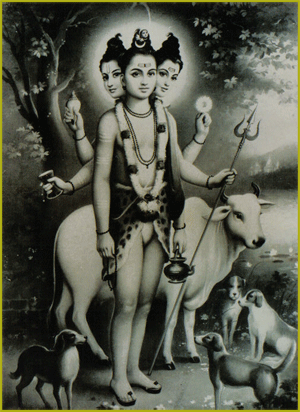
The symbols of Dattatreya
The cow is the Mother Earth and Dharma. She is Kamadhenu the wish-fulfilling cow.
The four dogs symbolize the four Vedas, the repositories of spiritual wisdom.
The trident indicates that He has transcended the three gunas, which constitute the illusory world: Sattva - illumination, Rajas - activity and Tamas - inertia.
The Sudharshana Chakra indicates that He is beyond the cycles of time that is past, present and future.
The Conch represents the eternal sound AUM, which is the sound manifestation of God, as well as the vital principle within us and the universe.
The Bhasma ashes indicate his detachment (vairāgya) and its purity. The ashes symbolize the fleeting nature of all matter.
The begging bowl teaches us that we should share our wealth and food with others.
The rosary (japa-mala), reminds us that our first duty is to chant the holy name of the Lord and meditate on Him.
Shri Dattatreya, to bless His devotees, wanders in the guise of a guest at lunchtime. That is why it is said that a guest should be treated as an incarnation of Dattatreya.
Dattatreya Yantra
Sripaada: paatu me paadaa vuru siddhaasana
stithaa: |
Paayaat digambaro guhyam nruhari: paatu me katim || 1 ||
Naabhim paatu
jagatsrashto daram paatu dalodara: |
Krupaalu: paatu hrudayam shadbhuja: paatu me bhujou || 2 ||
Srakkundii shoola
damaru shankha chakra dhara: karaan |
Paatu kantham kambukantha: sumukha: paatu me mukham || 3 ||
Jivhaam me
vedvaak paatu netre me paatu divyadruk |
Naasikaam paatu gandhaatmaa paatu punyasravaa: srutii || 4 ||
Lalaatam paatu
hansaatmaa shira: paatu jataadhara: |
Karmendriyaani paatviisha: paatu dyananendriyaanyaja: || 5 ||
Sarvantaronta: karanam praanaanme paatu
yogirat |
Uparishtaad adhastaachcha prushthata: paarshvatograta: || 6 ||
Antarbahishcha maam nityam naanaarupa
dharovatu |
Varjitam kavachenaa vyaatsthaanam me divyadarshana: || 7 ||
Raajata: shatruto
hinsraad dushprayogaa ditoghata: |
Aadhi vyaadhi bhayaartibhyo dattatreya: sadaavatu || 8 ||
Dhana dhaanya
gruha kshetra strii putra pashu kinkaraan |
Dyanaatiishcha paatu nityam me anasuyaananda vardhana: || 9 ||
Baalonmatta
pishaachaabho ddunit sandhishu paatu maam |
Bhoota bhoutika mrutyubhyo hari: paatu digambara: || 10 ||
Ya etat data
kavacham sannahyaad bhakti bhaavita: |
Sarva anartha vinarmukto grahapiidaa vivarjita: || 11 ||
Bhoota preta
pishaachaadyair devair apyaparaajita: |
Bhuktvaatra divya bhogaan sa dehaaAnte tat padam vrajet || 12 ||
Iti P. P. Shri Vasudevanand Saraswati virachitam Shri Dattatreya Kavacham sampurnam
1) Shri Laxmi stays at the feet of Shri Dattatreya. Hence let Shri Dattatreya protect my feet. Let Shri Dattatreya who sits in Siddhasana posture, protect my thighs. Let Digambar protect my anus and my reproductive organs. Let Nruhari protect my waist.
2) Let Jagatsastra protect my navel. Let Dalodara protect my stomach. Let
Krupalu protect my heart. Let Shatbhuja protect my shoulders.
3) Shri Dattatreya has held Mala, Kamandalu, Trishula, Damaru, Shankha and
Chakra in his six hands, Let my hands be protected by him. Let Kambukantha
protect my throat. Let Sumukha protect my mouth.
4) Let Vedvak protect my tongue. Let Divadruk protect my eyes. Let Gandhatma
protect my nose. Let Punyashrava protect my ears.
5) Let my forehead be protected by Hansatma. Let my head be protected by
Jatadhara. Let my organs which work for me by Ishwara and my organs which give
me knowledge be protected Aja.
6) Let my conscience be protected by Sarvantara. Let my Pranan be protected by
the king of Yogies. Let Yogiraj protect me from all ten directions.
7) Let Shri Gurudev Datta who can take many forms/incarnations; protect me in
and out of the house/body. Let anything which is not covered by this Kavacha, be
protected by Divadrushti.
8) Let
Gurudev Datta protect me from tyrant government, enemies, wield animals, bad
things performed to trouble me, my sins, mental diseases and disease of my body,
and all other troubles, difficulties.
9) Let son of Anusuya protect my money, food, my house, my wife, my children’s,
my pets, my servants and my relatives.
10) Let Balonmatta protect me in day, night and the period in between day and
night from all pancha mahabhutas (earth, water, fire, air and sky) and from
death.
11) Anybody reciting this Datta Kavacham with devotion and faith will become
free from all his troubles, difficulties and so also from troubles by planets
such as Saturn, Mars etc.
12) Ghosts, Demons etc. can’t trouble such devotee who recites this Kavacha
daily. He will become happy, all his desires will be fulfilled, become
successful in his endeavors and lead a healthy, wealthy and peaceful life. After
his death he will go to Datta Loka.
Here completes Shri Dattatreya Kavacham by Shri Vasudevanand
Saraswati.
Dattatreya Ashtottara Sata Namavali
